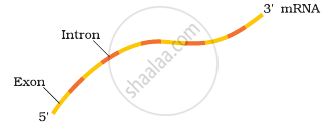Advertisements
Advertisements
Question
Give an account of post transcriptional modifications of a eukaryotic mRNA.
Solution
The primary transcripts (hn-RNA) contain both the exons and the introns and are non-functional. Hence, it is subjected to a process called splicing where the introns are removed and exons are joined in a defined order. Intron is the portion of gene which is transcribed but not translated. In prokaryotes, hnRNA is absent so splicing in not required. hnRNA undergoes additional processing called as capping and tailing. In capping an unusual nucleotide (methyl guanosine triphosphate) is added to the 5′-end of hnRNA. In tailing, adenylate residues (200 - 300) are added at 3′-end in a template-independent manner. It is the fully processed hnRNA, now called mRNA, that is transported out of the nucleus for translation.

Process of Transcription in Eukaryotes
APPEARS IN
RELATED QUESTIONS
Depending upon the chemical nature of the template (DNA or RNA) and the nature of nucleic acids synthesised from it (DNA or RNA), list the types of nucleic acid polymerases.
Answer the following question.
Construct and label a transcription unit from which the RNA segment given below has been transcribed. Write the complete name of the enzyme that transcribed this RNA.

Regulatory proteins are the accessory proteins that interact with RNA polymerase and affect its role in transcription. Which of the following statements is correct about regulatory protein?
The amino acid attaches to the tRNA at its ______.
In eukaryotes, the process of processing of primary transcript involves ______.
The most abundant type of RNA in the cell is ______.
The most likely method, used to determine the structural details of the cell organelle is ______.
What is the role of RNA polymerase III in the process of transcription in eukaryotes?
Identify the correct statement.
Observe the segment of mRNA given below.

(a) Explain and illustrate the steps involved to make fully processed hnRNA?
(b) Gene encoding RNA Polymerase I and III have been affected by mutation in a cell. Explain its impact on the synthesis of a polypeptide, stating the reasons.
